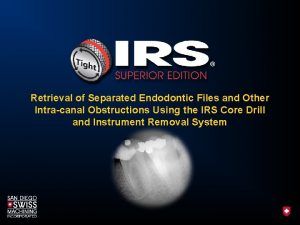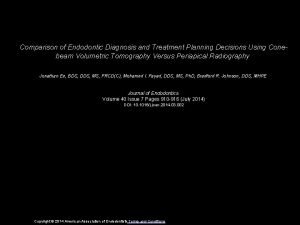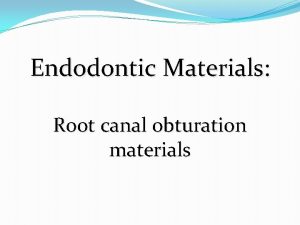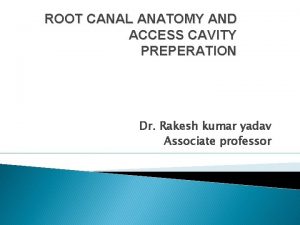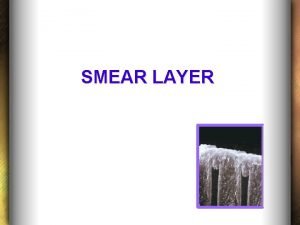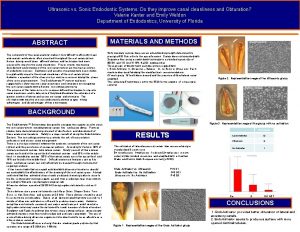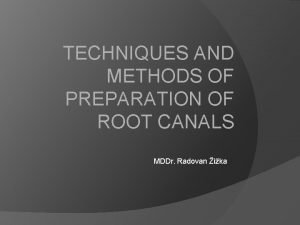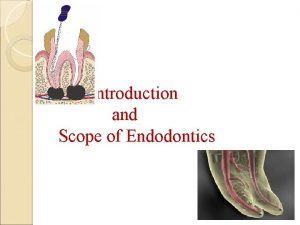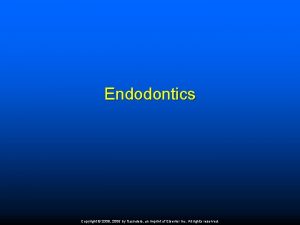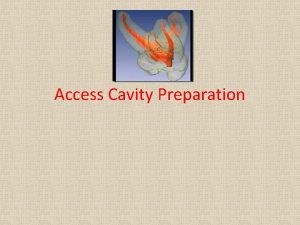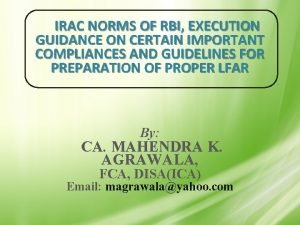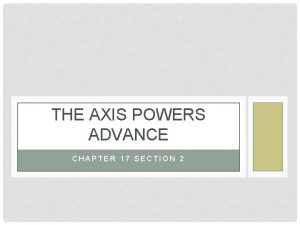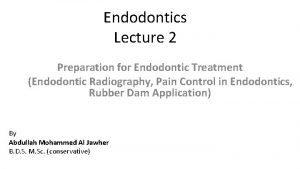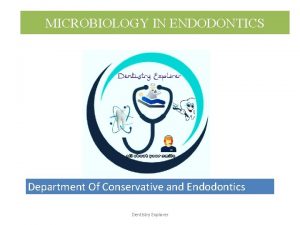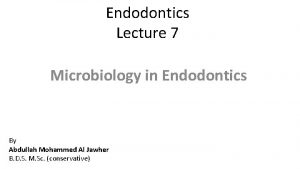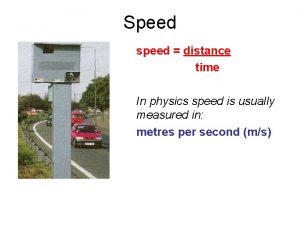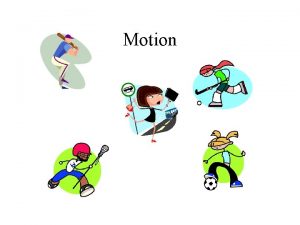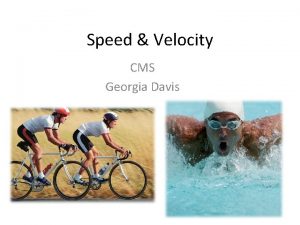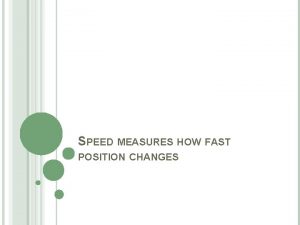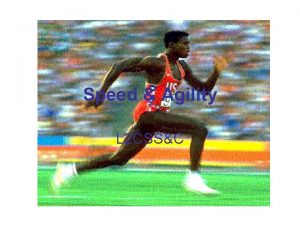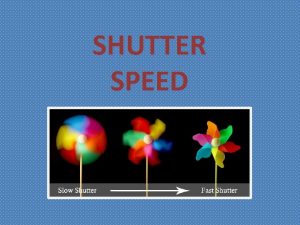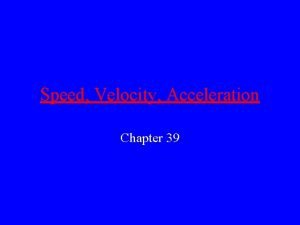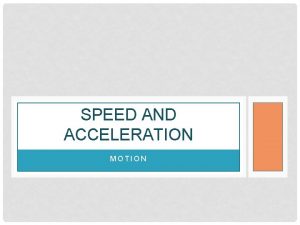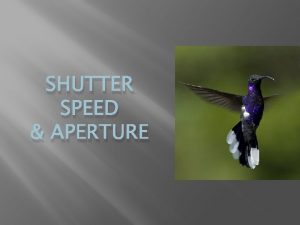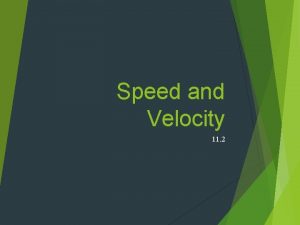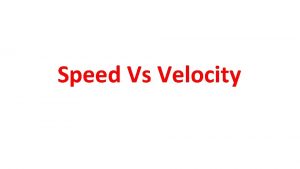Recent Advances In Endodontics Endodontic Imaging F speed
















































- Slides: 48

Recent Advances In Endodontics

Endodontic Imaging F speed film/sensor with rectangular collimation to conform to ALARA principle. Wireless sensors: CMOS (Complementory metal oxide semiconductors) PSP(photostimulable phospher plates)

• NEWER METHODS Radiographic Techniques Xero Radiography Digital Substraction Radiography Magnetic Resonance Imaging MRI Radiovisuography RVG Tuned aperture computed tomography TACT Tests To Determine Pulpal Blood Flow Laser Doppler Flowmetry Pulse Oximetry Thermographic imaging Hughes Probeye Camera

CBCT Some of the potential applications of CBCT include diagnoses related to the following: 1. Initial diagnosis where nonspecific signs and symptoms exist, 2. dental anomalies and developmental disturbances, 3. presence of anatomic variations, 4. calcified canals, 5. broken instruments, 6. vertical root fractures, 7. failure of prior treatment, 8. nonsurgical and surgical retreatments, 9. select cases of trauma, resorption (external and internal), and 10. implant placement.

MAGNIFICATION

Endoscope Designed to enable the practitioner to work inside the root canal with magnification and instrument access. The system includes three parts: �endoscopic compact system, � optical part that includes ocular part and the endoscope, and �handpiece with a disposable part.

• Diagnosis • Enhances visualization • Transillumination • Apical surgery • Endodontic observations during RCT

ORASCOPE flexible fiberoptic orascope is recommended for intracanal visualization, has a. 8 mm tip diameter, 0º lens, and a working portion that is 15 mm in length. The difference between an endoscope and an orascope is that: �an orascope is made of fibre-optics �an endoscope is made up of glass rods.


LOUPES

MICROSCOPES

Root canal preparation Healing of apical periodontitis + extended mechanical function of teeth = successful endodontic outcome. major factor that increases fracture susceptibility in endodontically treated teeth is the removal of bulk dentin during access and canal preparation strategies are being developed that retain more dentin, specifically in the coronal root third during shaping. vlimit coronal flaring vcompletely noninstrumental technique without the use of any canal preparation

o. Torque control devices (2 nd generation) • Nouvag TCM ENDO motor • Endo-Pro Electric • X- Smart • Protorq motor handpiece • Quantec ETM motor

o. Newest generation Tri-Auto ZX Combined with of the Root ZX Apex Locator, it can electronically monitor the root canal before, during and after instrumentation.




Root canal disinfection • Current advances in endodontic disinfection are aimed toward: a. Improving the fluid dynamics during root canal irrigation — improving bubble dynamics and activating intensified cavitational bubbles. b. Developing newer antimicrobials, which demonstrate potent antibiofilm effect over sodium hypochlorite


PRESSURE ALTERNATING DEVICES ENDOVAC SYSTEM • In the Endo. Vac system (Discus Dental, Culver City, CA), has three components: 1. Master delivering tip 2. Macro cannula 3. Micro cannula 20


VIBRINGE • Vibringe (Vibringe BV, Amsterdam, The Netherlands) is a new sonic irrigation system that combines battery-driven vibrations (9000 cpm) with manually operated irrigation of the root canal. • Vibringe uses the traditional type of syringe/needle delivery but adds sonic vibration.

Antibacterial nanoparticles (NPs) • 1 -100 nm • Broad spectrum antimicrobial activity • Far lower tendency to induce microbial resistance • Electrostatic interaction between positively charged NPs & negatively charged bacterial cells – loss of membrane permeability & function • SEALERS loaded with NPs

Currently, functionalized NPs are being developed to eliminate bacteria more specifically without damaging the host cells (targeted antibacterial efficacy) and to repair previously infected dentin matrix.

Antimicrobial photodynamic therapy • Step 1: application of a photosensitizer • Step 2: light illumination of sensitized tissue

PHOTO ACTIVATED DISINFECTION • It includes PDT/LAT i. e photo dynamic therapy or light activated therapy. Light of specific wavelength Photosensitizer Activation (tolonium chloride) Oxygen based free radical formed Multiple Targets Membrane damage Genetic damage on • Optic fibre may be used to direct the irradiation to the intended side of application. Enzyme inactivati

SELF ADJUSTING FILE • It has a hollow thin walled cylinder composed of a thin nickeltitanium lattice. • It is compressible and adjusts to the anatomy of the root canal. • SAF operates with a continuous flow of irrigant (5 ml/min) running through the instrument. • The vibrating movement of SAF within the irrigant facilitates its cleaning and debriding effects.

• Root canals vary greatly in their cross-sectional anatomy, and oval, flat, and C-shaped canals are commonly found • SAF is designed to efficiently prepare root canals that do not have a round cross section because the compressible file adapts its shape to the canal anatomy. • It is operated with a modified Ka. Vo handpiece that generates in and out vibrations with 5000 vibrations/min and 0. 4 mm amplitude. • Irrigation unit is used to deliver a constant flow of irrigant.

29

Photon-induced photoacoustic streaming • It is based on the direct shock wave generated by a erbium: YAG (Er: YAG) Laser in a liquid irrigant. • The laser system is equipped with a fiberoptic delivery tip • When activated in a limited volume of fluid, the high absorption of Er: YAG wavelength combined with the high peak power derived from the short pulse duration resulted in an enhanced bubble dynamics, which improved the irrigant flow dynamics within the root canal.

Gentlewave irrigation • It delivers sodium hypochlorite into the root canal under pressure through a specialized handpiece, which is activated by a broad spectrum of acoustic waves. At the same time, suction removes the outflowing fluid through the handpiece. • A silicon ring surrounding the extremity of the handpiece • creates a tight seal with the artificially created flat tooth surface. • This system is expected to enhance irrigation dynamics in minimally enlarged root canals.

Obturation

The injectable thermoplasticized guttapercha obturation techniques 1. 2. OBTURA II SYSTEM ULTRAFIL LOW TEMP THERMOPLASTICIZED GUTTAPERCHA • • • 3. INJECTION AND MASTER CONE : REGULAR SET – FIRM SET INJECTION AND VERTICAL COMPACTION INJECTION AND LATERAL CONDENSATION – FIRM SET OR REGULAR SET TRIFECTA – SUCCESSFIL PLUS ULTRAFIL MODIFIED TRIFECTA SUCCESSFIL PLUS LATERAL / VERTICAL COMAPCTION ENDONTIC OBTURATORS • • SIMPLIFIL THERMAFIL ALPHASEAL J. S QUICKFIL (THERMOMECHANICAL)

ROOT CANAL SEALANTS • Calcium silicate sealers: • Bioactive property • Promote calcium phosphate precipitation in a wet environment • Nano bioactive glass particles based GP: • Immediate sealing property in heated form

The injectable thermoplasticized guttapercha obturation techniques

• Low heat Gutta Percha at 70 degrees celsius ULTRAFIL • Pre set heater at 90 deg celsius for 15 mins • Ultrafil – 3 types • Regular set – white canule / low viscosity ; setting time = 30 mins • Firm set – b; ue canule – moderate visosity – more condensable with pluggers • Endo set – Green canule ; setting time 2 mins / high viscosity Prefilled gutta percha cannules for Ultrafil

OBTURA II High heat Temp 160 deg celsius Disposable silver needles for Obtura II Loading Obtura Gun with gutta percha

THERMAFIL


Success. Fil

Expanding Therapeutic Boundaries: Regenerative Endodontics

v Regenerative endodontics: is a biologically based procedure designed to replace damaged structures, Dentin and root structures Cells of the pulp-dentin complex v Vital pulp therapy with pulp stem/progenitor cells might regenerate dentin-pulp complex without the removal of the whole pulp.

v Caries, pulpitis, and apical periodontitis ultimately result in premature tooth loss and therefore diminishing the quality of life v Regeneration of parts of the tooth structure can prevent or delay the loss of the whole tooth.

The key ingredients for tissue engineering

REVASCULARIZATION TISSUE ENGINEERING

q Stem cell: ability to; Continuously divide to either replicate itself (self-renewing), or Produce specialized cells than can differentiate into various other types of cells or tissues (multilineage differentiation) v Embryonic stem cells derive from the early mammalian embryo at the blastocyst stage and have the capability to give rise to all kinds of cells. (Pluripotent) v Adult /Postnatal stem cells are just multipotent because their differentiation potential is restricted to certain cell lineages

ØFirst human dental pulp stem cells were isolated in 2000. Currently at least five different types of mesenchymal stem cells have been isolated from the dental tissues, including Ødental pulp stem cells (DPSC), Østem cells of human exfoliated deciduous teeth (SHED), Østem cells of the apical papilla (SCAP), Ødental follicle progenitor cells (DFPC) and stem cells from periodontal ligament. ØAmong these, DPSC, SHED and SCAP show stronger potential for pulp regeneration.

 Recent advances in dental ceramics
Recent advances in dental ceramics Frc driver station mac
Frc driver station mac Irs kit endo
Irs kit endo Biocalex
Biocalex Endodontic diagnosis and treatment planning
Endodontic diagnosis and treatment planning Silver cone obturation disadvantages
Silver cone obturation disadvantages Spreaders and pluggers ppt
Spreaders and pluggers ppt Law of access cavity preparation
Law of access cavity preparation What is smear layer
What is smear layer Ultrasonic vs sonic
Ultrasonic vs sonic Maf endo
Maf endo Enamel bevel definition
Enamel bevel definition Endodontist definition
Endodontist definition Chapter 54 endodontics
Chapter 54 endodontics Definition of access opening in endodontics
Definition of access opening in endodontics Creekside endodontics
Creekside endodontics Lingual surface
Lingual surface Root canal sealers
Root canal sealers Irac circular rbi
Irac circular rbi Tally solutions pvt ltd
Tally solutions pvt ltd I was not aware
I was not aware Lurbinectedin posologie
Lurbinectedin posologie Advances in technology during wwii
Advances in technology during wwii What is long term loans and advances
What is long term loans and advances Advances in memory technology
Advances in memory technology Lesson 9.1 intellectual advances in the first year
Lesson 9.1 intellectual advances in the first year Opto-electronic advances
Opto-electronic advances Chapter 17 section 2 the axis advances
Chapter 17 section 2 the axis advances Advances in real time rendering
Advances in real time rendering While driving drivers experience the emotion of
While driving drivers experience the emotion of Speed detection of moving vehicle using speed cameras ppt
Speed detection of moving vehicle using speed cameras ppt Calculating time with distance and speed
Calculating time with distance and speed Trends in india foreign trade
Trends in india foreign trade Recent activitycourse dashboard
Recent activitycourse dashboard Recent developments in ict
Recent developments in ict Emerging trends in mis
Emerging trends in mis Passive headlines
Passive headlines Advantages of scanning and skimming
Advantages of scanning and skimming Biotaphonomy
Biotaphonomy Recent developments in object detection
Recent developments in object detection Comait
Comait Modern trends in project management
Modern trends in project management Https drive google com
Https drive google com Jose has just played a long bruising football game
Jose has just played a long bruising football game Many recent college graduates have faced
Many recent college graduates have faced Recent demographic changes in the uk
Recent demographic changes in the uk Recent trends in ic engine
Recent trends in ic engine Udin login
Udin login A friend emails you the results of a recent high school
A friend emails you the results of a recent high school


